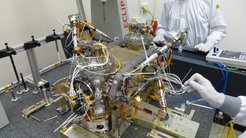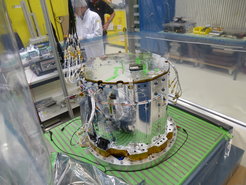LISA Pathfinder: Science payload completed and integrated into the satellite
Next steps: Shipment to Kourou and launch in autumn
After more than 10 years of intense development, the highly sensitive science payload of the LISA Pathfinder Mission (LPF) has been completed and integrated into the satellite. The science instruments are the core of the mission.

“LISA Pathfinder will test novel technologies in space whose function and performance cannot be tested on the ground at all or only in a limited fashion. LPF will pave the way for the gravitational wave observatory eLISA,” says Prof. Karsten Danzmann, Director at the AEI and professor at the Leibniz Universität Hannover. eLISA (evolved Laser Interferometer Space Antenna) is scheduled for launch in 2034.
While the LPF scientists continue preparing for LPF mission operations, the industrial partner Airbus DS supervised by the European Space Agency (ESA) is running the final tests on the assembled spacecraft. Shipment to the ESA spaceport Kourou in French Guyana is planned in August and mission lift-off on a Vega launcher in the autumn. The mission operations phase will begin once LPF has reached its destination: for a period of several months the scientist will test the high-precision science instruments on board while maintaining regular contact with the satellite.

LISA Pathfinder is an ESA mission, with the European space industry and research institutions from France, Germany, Italy, the Netherlands, Spain, Switzerland and Great Britain as well as NASA participating.
The Max Planck Institute for Gravitational Physics (Albert Einstein Institute/AEI) in Hannover played a leading role in the development and construction of the scientific instrumentation for LISA Pathfinder. Joint scientific leadership is held by Prof. Karsten Danzmann and Prof. Stefano Vitale from the University of Trento, Italy.
LISA Pathfinder is funded by the Federal Ministry for Economic Affairs and Energy based on a resolution of the German Bundestag.













